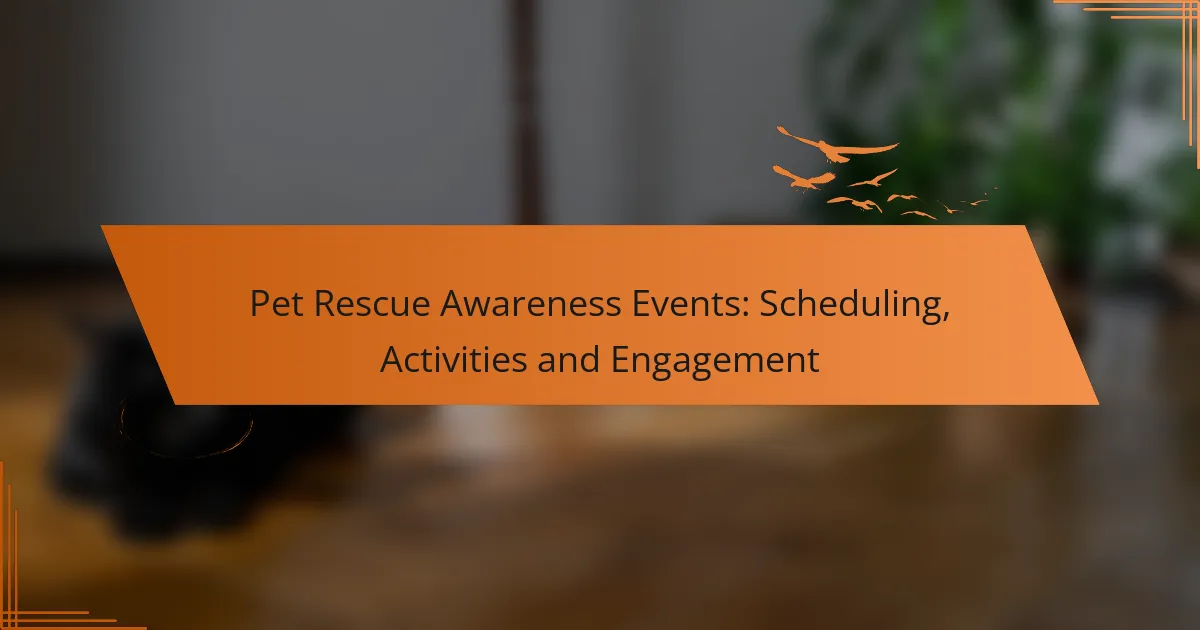Organizing a pet rescue awareness event is a vital step in promoting support for local shelters and rescue organizations. It requires careful planning, including setting clear goals, selecting an appropriate venue, and scheduling engaging activities that cater to both pets and their owners. By creating a well-structured event, you can effectively raise awareness and foster community involvement in pet rescue efforts.

How to plan a pet rescue awareness event in the United States
Planning a pet rescue awareness event in the United States involves setting clear goals, managing a budget, and engaging the community. A well-organized event can significantly raise awareness and support for local shelters and rescue organizations.
Define event goals
Start by identifying the primary objectives of your event. Common goals include raising funds for local shelters, increasing adoption rates, or educating the public about responsible pet ownership. Clearly defined goals will guide your planning process and help measure success.
Consider involving stakeholders, such as local shelters and volunteers, in goal-setting discussions. Their insights can help shape the event’s focus and ensure it meets community needs.
Create a budget
Establishing a budget is crucial for a successful event. List all potential expenses, including venue rental, permits, marketing materials, and refreshments. A typical budget for a small to medium-sized event might range from a few hundred to several thousand dollars, depending on the scale.
Seek sponsorships from local businesses or grants from animal welfare organizations to offset costs. This not only helps with funding but also builds community partnerships.
Set a timeline
Develop a timeline that outlines key milestones leading up to the event. Start planning at least three to six months in advance to allow ample time for logistics, marketing, and coordination. Include deadlines for securing the venue, finalizing vendors, and launching promotional activities.
Regularly review your timeline to ensure you stay on track. Adjust dates as necessary to accommodate any unforeseen challenges or opportunities.
Engage local shelters
Collaborating with local shelters is essential for a successful pet rescue awareness event. Reach out to them early in the planning process to discuss how they can participate, whether through providing animals for adoption, sharing resources, or helping with logistics.
Consider hosting joint events or offering incentives for shelters to participate, such as a shared booth space or promotional opportunities. This partnership can enhance the event’s credibility and attract more attendees.
Promote through social media
Utilize social media platforms to promote your event effectively. Create engaging posts that highlight your goals, featured pets, and event details. Use local hashtags and tag participating shelters to expand your reach within the community.
Consider running targeted ads on platforms like Facebook or Instagram to reach a broader audience. Encourage attendees to share the event with their networks to increase visibility and engagement.

What venues are suitable for pet rescue events?
Suitable venues for pet rescue events include spaces that can accommodate both animals and attendees comfortably. Key factors to consider are accessibility, safety, and the ability to provide necessary amenities for pets and their owners.
Parks and outdoor spaces
Parks and outdoor spaces are ideal for pet rescue events due to their open areas and natural settings. These venues allow for ample space for activities such as pet adoptions, demonstrations, and socialization. Ensure the park has adequate facilities like restrooms and waste disposal stations.
Consider the weather when planning an event in an outdoor space. Spring and early fall are often the best times, avoiding extreme temperatures that could affect both pets and attendees. Always have a backup plan in case of inclement weather.
Community centers
Community centers provide a controlled environment that can be beneficial for pet rescue events. They often have indoor spaces that can accommodate larger crowds and provide shelter from the elements. Look for centers that allow pets and have accessible facilities.
When selecting a community center, check for availability and any associated rental fees. Many centers offer discounted rates for non-profit organizations, which can help keep costs low for your event.
Pet-friendly venues
Pet-friendly venues, such as cafes, breweries, or event halls that welcome animals, can create a lively atmosphere for pet rescue events. These locations often have built-in amenities like seating and refreshments, making them attractive for attendees.
Ensure that the venue has clear policies regarding pets and that it can accommodate the expected number of animals. Collaborating with the venue can also lead to promotional opportunities, benefiting both the rescue organization and the business.
Local businesses
Partnering with local businesses can enhance pet rescue events and draw in more attendees. Stores that sell pet supplies or services may be willing to host events or sponsor activities, providing visibility for both the rescue and the business.
When approaching local businesses, present a clear value proposition, such as increased foot traffic or community goodwill. Consider co-hosting events that align with their brand, like adoption days or pet care workshops, to create a mutually beneficial relationship.

How to schedule activities for a pet rescue event
Scheduling activities for a pet rescue event involves careful planning to ensure a smooth and engaging experience for attendees. Focus on creating a balanced mix of fun, informative, and adoption-related activities to maximize participation and awareness.
Plan engaging activities
Engaging activities are essential for attracting attendees and keeping them entertained. Consider including pet contests, training demonstrations, and interactive workshops that allow participants to learn about pet care and rescue efforts.
Incorporate a variety of activities to cater to different age groups and interests. For example, you might host a pet costume contest for families while offering educational sessions for adults on responsible pet ownership.
Coordinate with local vendors
Partnering with local vendors can enhance your event and provide valuable resources. Reach out to pet supply stores, groomers, and veterinarians to see if they would like to participate by offering services, products, or sponsorships.
Establish clear communication with vendors about their roles, responsibilities, and any fees involved. This can help ensure that both parties are aligned on expectations and can contribute to a successful event.
Include adoption opportunities
Including adoption opportunities is a key aspect of any pet rescue event. Collaborate with local shelters and rescue organizations to showcase pets available for adoption, providing a chance for attendees to meet and interact with them.
Set up designated areas for adoption discussions, complete with information on the adoption process, fees, and requirements. This can facilitate connections between potential adopters and pets, ultimately increasing the chances of successful adoptions.

What are the key considerations for venue selection?
When selecting a venue for a pet rescue awareness event, key considerations include accessibility for attendees, adequate space for pets and activities, and compliance with permits and regulations. These factors ensure a successful event that attracts participants and supports the mission of pet rescue.
Accessibility for attendees
Accessibility is crucial for ensuring that all potential attendees can participate in the event. Consider locations that are easily reachable by public transportation and have ample parking. Additionally, venues should be wheelchair accessible and provide accommodations for individuals with disabilities.
It’s also beneficial to assess the venue’s proximity to local communities and neighborhoods where pet lovers reside. This can help maximize attendance and engagement during the event.
Space for pets and activities
The venue must have sufficient space to accommodate both pets and various activities planned for the event. Consider areas for pet demonstrations, adoption booths, and interactive activities that engage attendees. A spacious outdoor area can be ideal for pet play zones and socialization.
Ensure that the layout allows for a smooth flow of foot traffic, preventing overcrowding and ensuring safety for both pets and people. A good rule of thumb is to allocate at least 10 square meters per pet for comfort and movement.
Permits and regulations
Before finalizing a venue, check local regulations and obtain any necessary permits for hosting an event involving animals. This may include health and safety regulations, liability insurance, and specific permits for outdoor gatherings.
Consult with local authorities to understand the requirements and ensure compliance. Failing to secure the appropriate permits can lead to fines or cancellation of the event, so it’s essential to address this early in the planning process.

How to promote your pet rescue awareness event effectively
To promote your pet rescue awareness event effectively, focus on clear messaging, targeted outreach, and engaging content. Utilize social media, local partnerships, and community involvement to reach a wider audience and encourage participation.
Utilizing social media platforms
Social media is a powerful tool for promoting your pet rescue awareness event. Create event pages on platforms like Facebook and Instagram, and share engaging content such as photos of pets available for adoption, success stories, and event details. Use relevant hashtags to increase visibility and encourage attendees to share your posts.
Consider running targeted ads on these platforms to reach specific demographics interested in animal welfare. Allocate a modest budget for ads, focusing on local audiences to maximize engagement and attendance.
Engaging local businesses and organizations
Partnering with local businesses and organizations can significantly enhance your event’s visibility. Approach pet stores, veterinary clinics, and community centers to see if they would be willing to display flyers or share information about your event. In return, offer to promote their services during the event.
Collaborating with local animal shelters or rescue groups can also amplify your reach. Jointly hosting the event can attract a larger audience and provide additional resources for planning and promotion.
Creating compelling promotional materials
Effective promotional materials are crucial for attracting attention to your pet rescue awareness event. Design eye-catching flyers, posters, and social media graphics that clearly communicate the event’s purpose, date, time, and location. Use high-quality images of pets to evoke emotion and encourage participation.
Consider including a call-to-action, such as “Join us to help find forever homes for pets in need!” This can motivate potential attendees to engage with your event and share it with their networks.
Leveraging community events and networks
Participating in local community events can provide an excellent platform for promoting your pet rescue awareness event. Set up a booth at farmers’ markets, fairs, or festivals to distribute flyers and engage with attendees. Offer small giveaways, such as pet treats or branded merchandise, to draw interest.
Utilize local community boards, newsletters, and online forums to spread the word. Engaging with community networks can help you reach individuals who are passionate about animal welfare and may be interested in attending your event.



